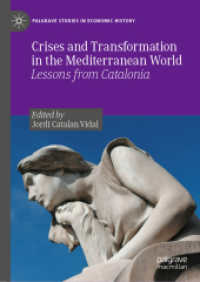Full Description
The book examines the myth of Hercules and Omphale/Iole which became an important topic in the visual arts in the period 1500-1800. It offers an analysis of the iconography from the perspective of the history of emotions, classical and Neo-Latin philology, reception studies, and gender studies. The early modern inventions of the myth excel in a skilful display of mixed and compound emotions, such as the male character's psychopathology, and of the theatrical performance of emotions by the female character.
Contents
Acknowledgements
List of Illustrations
Note on the Author
1 Introduction: the Relevance of the Myth of Hercules and Omphale for the History of Emotions
2 Hercules and Omphale: the Myth in the Literary Tradition of Greek and Roman Antiquity and of the Middle Ages
3 Boccaccio's De mulieribus claris: Psychopathology of Love, Hercules's furor and Yole's Strategy of Cunning
3.1 The Origins of Boccaccio's Blurring of Iole and Omphale in De mulieribus claris: Petrarch's De viris illustribus
3.2 Yole's Destructive Strategy of Feigned Emotions
3.3 Boccaccio's Psychopathology of Love and the Stoic Theory of Affectus
3.4 Mythological Figures as Human Beings from Flesh and Blood: Euhemerism in De mulieribus claris and in Genealogiae deorum gentilium
3.5 The Religion of Fame: Historical Writing on Women by Boccaccio and Petrarch
3.6 Compositional, Rhetorical, and Evaluative Peculiarities of De mulieribus claris
3.7 The Impact of De mulieribus claris
3.8 The Importance of Boccaccio's De mulieribus claris, Chapter 23, for the History of Emotions: the Theatrical Performance of Emotions, and the Expression of Complex, Compound, and Mixed Emotions
4 A Bestseller of the Cranach Factory: Hercules furens as Didactic Tragicomedy of "Weiberlist" (Women's guile) and "Weibermacht" (Women's Power)
5A Women's Guile in Manuscript Illuminations of De mulieribus claris and 16th-Century Representations of the Myth
5B The Myth as Allegorical Court Satire on the Bad Ruler: Dosso Dossi (ca. 1535-1537)
6 Erotic Farce: Bartholomeus Spranger's Invention of the Myth as Brothel Scene (ca. 1585-1600)
7 The Invention of the Myth as Multimedia Entertainment: Gillis Coignet (1590-1599)
8 Hercules furens as Tragedy and as Comedy: Alessandro Turchi's Pendant Paintings in the Alte Pinakothek (ca. 1620)
9 Comedy and Courtly Decorum: Adaptations and Transformations of Spranger's Brothel Scene, 1600-1800
10 How Low Can Hercules Go? - the Development of Spranger's Brothel Scene as Vulgar Farce in the 17th and 18th Centuries
11 Music and Madness, Furor and Frenzy: Staging the Myth as Bacchus Feast and Sacred Marriage (Statius, Ovid's Fasti)
12 Hercules's Perturbatio mentis and Female Emotions of the Male Hero
13 Iole's/Omphale's Triumph or 'omnia vincit amor' - the Compound of Triumphant Emotions
14 The Humiliation of the Male: Slapstick Humour, Physical Violence
15 Omphale as a Moral Example of Chastity and Template for a Female Political Leader? - Simon Vouet's Comedy and Tragedy of Love
16 Sincere Love or Feigned Love? The Art of Creating Ambiguous Emotional Compounds and Erotic Tension
17 From Feigned Love to Performative Erotic Techniques: Nude Dance, Dress-Dropping, Erotic Motion, Striptease
18 Conclusion
18.1 The Iconography of the Myth and Its Consequences: Iconographic Constructions as Settings for Women's Guile, Gender Relations, and the Expression of Emotions
18.2 The Contribution of the Visual Representations of Hercules and Omphale to the Early Modern Discourse on Emotions: Study of the Various Shades of affectus/furor
Bibliography
Index Nominum








